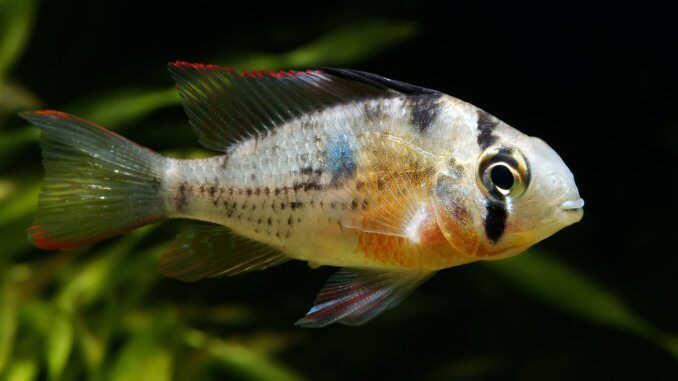
Bolivian rams are colorful, peaceful and easygoing.
They can be quite shy and will not bother any other fish in your tank so they make great additions to a community fish tank.
This fish will liven up your aquarium with striking colors and funny swimming behaviors. From yellow to red and silvery blue, Bolivian Rams will definitely stand out in you tank.
These fish are perfect for beginners – breeding these fish can be quite rewarding too!
Read our complete care guide to keeping these amazing fish. We cover everything from tank conditions to dietary requirements, as well as some helpful tips on how to breed them.
TABLE OF CONTENTS
Bolivian Ram Facts & Overview
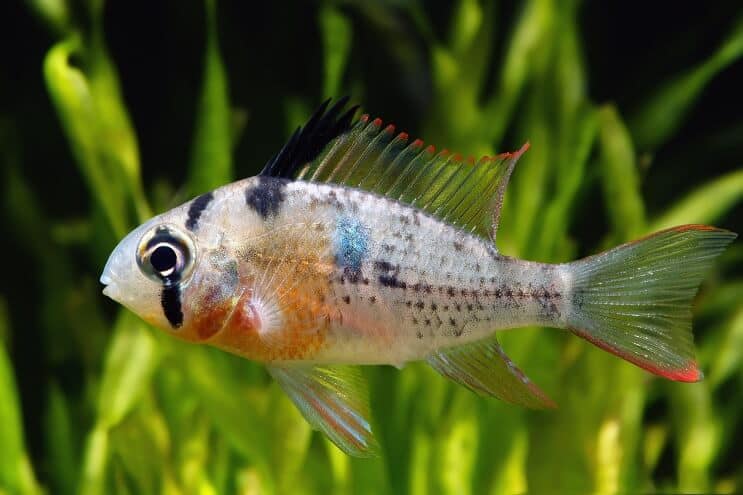
| Category | Rating |
| Care Level: | Beginner |
| Temperament: | Peaceful |
| Color: | Colorful |
| Lifespan: | 4 years |
| Size: | 3.5 inches |
| Diet: | Omnivore |
| Family: | Cichlidae |
| Minimum Tank Size: | 30 gallons |
| Tank Setup: | Freshwater |
| Compatibility: | Other peaceful freshwater fish |
The Bolivian ram (Mikrogeophagus altispinosus) is known under many common names: butterfly ram, Bolivian butterfly cichlid, and ruby cichlid.
Bolivian rams are cichlids and unlike their closely related cousins (such as the green terror cichlid) they are peaceful. They belong to the Cichlidae family which is the largest group of freshwater fish.
This family is very popular in the aquarium trade and includes fish such as angelfish, oscars, and discus.
This cichlid is quite hardy and with the right water conditions and care, the Bolivian ram can live for up to 4 years.
Native to South America, Bolivian rams are widely available and you should expect to pay around $10 for a good specimen.
Typical Behavior
Even though cichlids are well known to be the bullies of most aquariums, this fish is an exception – the Bolivian ram is a peaceful fish.
This serene fish spends most of its time in the lower and middle parts of the tank.
Their swimming behavior is unique; they typically move for a few strokes and then stop suddenly, over and over again. They do this when feeding so they can sieve through the sediment whilst not stirring it up.
Apart from the occasional peculiar swimming style when looking for food, Bolivian rams look quite graceful and can swim quite quickly when trying to evade predators.
Appearance
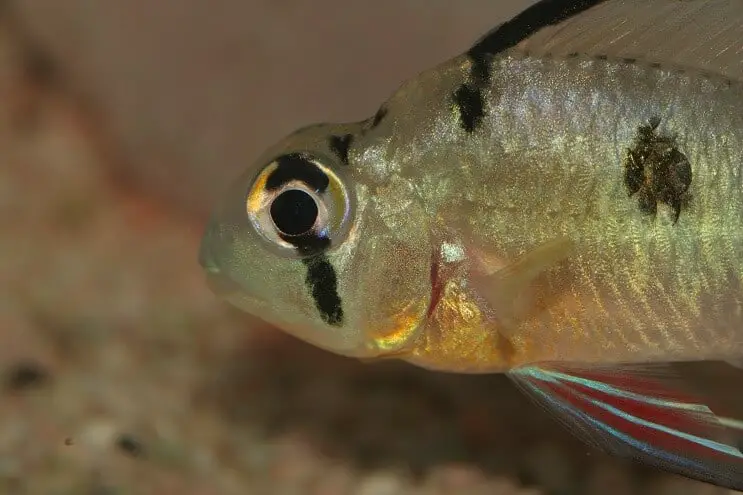
Bolivian rams are small colorful fish.
They have an elongated oval-shaped body that reaches around 3.5 inches once fully grown. Interestingly they have a small series of spiky ray-shaped fins and tails – this is a typical characteristic of ray-finned fishes.
Their striking body colors range from almost dull brown to grayish-blue. They have yellow bellies which sometimes extend to the front.
They are often recognizable for their distinctive black spot in the middle of their body with some specimens having a black line between their eyes. Fins and tails are orange along the edges.
This species shows sexual dimorphism. Males are usually bigger with pointed dorsal fins and longer filaments along the tail than females. Females are also smaller reaching only about 2.5 inches.
To help against predators, they have spiny rays on their fins. These rays can be quite dangerous as they can strangle and suffocate the predator with them. The front part of their fins is soft to allow them to swim gracefully.
Care
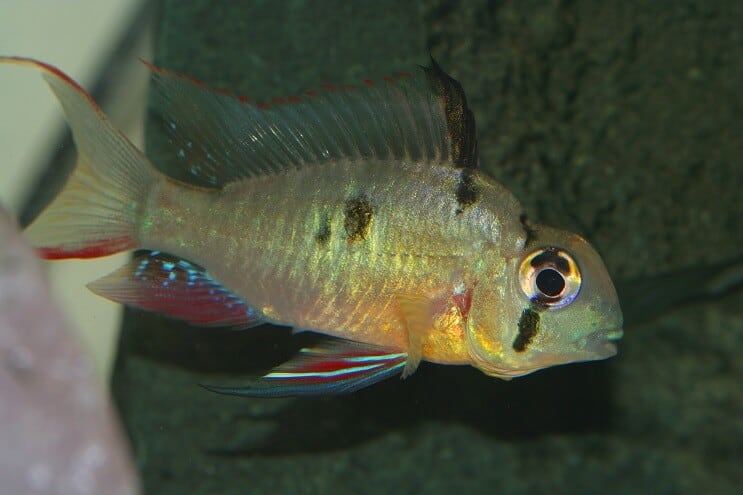
Bolivian rams are hardy fish and providing they have good quality water (that is well oxygenation) they should be healthy and happy fish.
However, there are still some parasitic, bacterial, and fungal infections that might find their way into your aquarium.
A very common problem is the white spot disease known as ich. This is a parasite that appears as white spots on the skin of the fish. As Bolivian rams are quite tolerant of water temperature you can initially try to elevate the temperature to 86°F and see if it goes away.
If the parasite is persistent you will need a more aggressive treatment such as copper.
Remember treatments can vary slightly between medicine brands, so check with your local veterinary.
Often parasites and infections are introduced from external objects introduced in the tank.
Always make sure to quarantine and thoroughly clean any new addition, from plants to a new fish. A good habit is to quarantine any new living addition to the tank and thoroughly clean any new objects.
Tank Setup
The Bolivian ram is native to the freshwater systems of Brazil and Bolivia.
They are quite hardy fish and are tolerant of many water conditions.
To provide them with the best conditions, it is best to mimic their natural environment. The streams, pools, and lagoons where you can find these fish are usually dense with vegetation and have plenty of submerged branches and roots offering shelter and shade.
These waters are slow-moving and slightly acidic (pH 6.0-7.4) with lots of organic matter and food to feed on, with sandy and muddy bottoms.
Therefore the tank should be heavily planted with open spaces for swimming and plenty of rocks, driftwood, and hiding places. Some good aquatic plants that you can use in your tank are Java fern, Amazon sword, anubias nana, and wisteria.
Fine sand with some pebbles here and there can be used as substrate. They prefer low lighting with weak water movements.
For water conditions, a temperature of 74.0-78.0°F is good with a water hardness in the range of 6-14 dGH.
Make sure to provide enough water changes to keep nitrates levels in check as they can be quite toxic for this fish.
They don’t need big tanks, a 30-gallon tank is fine for a single specimen; allow an extra 5-10 gallons per ram you add.
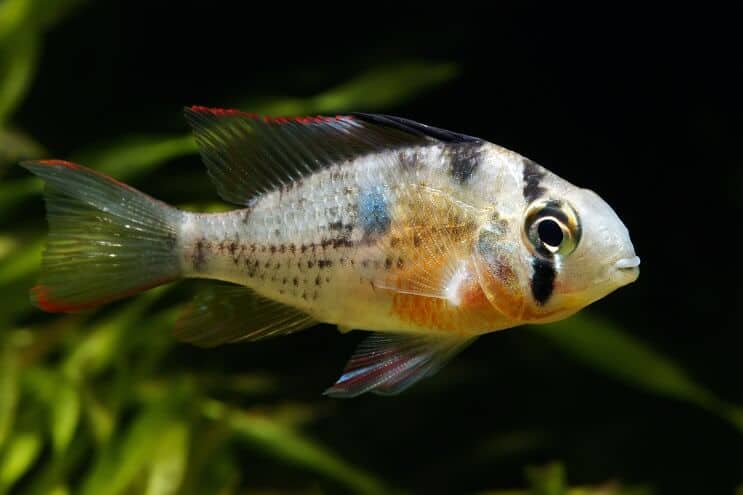
Tank Mates
Bolivian rams are the perfect cichlid for community aquariums. They are peaceful fish that will struggle with aggressive tank mates.
They can be kept with other dwarf cichlids and peaceful tank mates such as silver dollar fish, dwarf gouramis, rummy nose tetras, or emperor tetras, corydoras catfish, plecostomus, guppies, platies, Odessa barbs, and tiger barbs.
Overall, they are quite shy and tend not to interact much with other tank mates.
The biggest factor when choosing a tank mate for them is size. If tank mates are too small, they can be seen as prey and might be eaten.
When thinking about adding non-fish inhabitants, size again is what matters. Bolivian rams might mistake small shrimps like the cherry shrimp for food while larger species such as the ghost shrimp, amano shrimp, or bamboo shrimp are fine.
Keeping Bolivian Rams Together
Bolivian rams are good to keep together in small groups. There is no right or wrong here, they do well both alone, in a pair, or in a group.
If you want to breed them, get a group of 4-8 then let them pair off and separate the couples. Squabbles among the school are common and usually harmless. Ensure they have a big enough tank (55+ gallon), and all will be fine.
Diet
Bolivian rams are very easy to feed, they are not fussy eaters and will eat almost everything.
They are omnivores with a diet that mainly comprises riverbed detritus such as plants and various seeds. In the wild, they tend to sieve through the substrate for plant material and small organisms. Occasionally, they will also feed on insects or plants at the water surface.
You should try to keep a varied and balanced diet in your tank with flakes or pellets and a mixture of live or frozen meaty foods such as brine shrimps, blood, or white worms. Chopped earthworms are also good alternatives.
As they are bottom feeders, you should consider pellets more than flakes. Pellets sink to the floor more easily than flakes.
You can feed them small portions of food several times per day, usually 2-5 pinches of food over the day. A large quantity of food once a day can deteriorate water quality while small pinches of food several times per day allow you to maintain a higher water quality over time.
Breeding
Breeding Bolivian rams is fairly easy and straightforward once you manage to find a mated pair.
When in their natural environment, they are open spawners, forming a family group and laying about 100 eggs.
In your aquarium, it is going to be a bit more complicated.
If you choose a random couple from the pet shop it’s difficult to know if they will get along. It is easier to get a juvenile group of about 8-10 fish and let them partner off.
It is not strictly necessary to separate the couple for breeding. However, you will have to ensure that the right conditions are met in the community tank.
The first thing they need is space (50+ gallons). They also must have shelter such as caves, large stones, large snags, and leaves to lay eggs on. You should also consider that eggs might get eaten by other tank inhabitants.
Water temperature should be quite warm, 77-82°F with low light. The pair will spend some time cleaning and prepping the area before spawning. When the couple is ready, the female tends to swim over the spawning sites several times laying eggs while the male protects the area.
Now is the male’s turn to swim over the eggs and externally fertilize them. Finally, both fish will fan the eggs.
The eggs will hatch within 60 hours and then will be moved to a different area of the tank. Fry will be free swimming in about 7 days. Here the couple will gently move the fry to several locations during the following weeks.
Rams are quite sensitive to nitrates and therefore they need daily water changes (at least 30%).
Fry can be fed with shrimp naupii or vinegar eels.
Once the fry reach 2 months old, you can feed them like you would an adult Bolivian ram.
Are Bolivian Rams Suitable for your Aquarium? (Summary)
Bolivian rams are South American cichlids perfect for community aquariums and for beginners. With striking colors and a great personality, this fish will fit right in.
It will get along well with most peaceful of similar size fish. Smaller fish can be mistaken for food though so watch out!
They are quite hardy fish with a high tolerance for temperature shifts – just make sure to keep the tank clean.
Remember you still need to watch out for common parasites in freshwater aquariums and make sure you thoroughly clean any additions to the established environment.
Ready to keep a Bolivian Ram as a tank mate? Leave a comment in the section below to let us know your experiences…

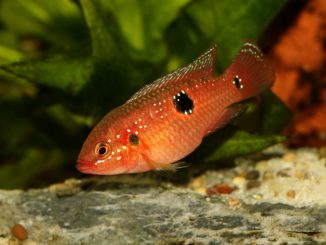
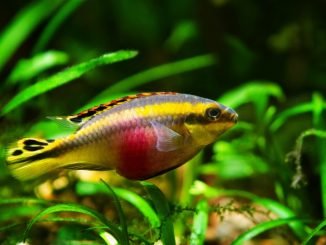
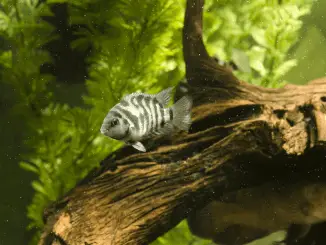
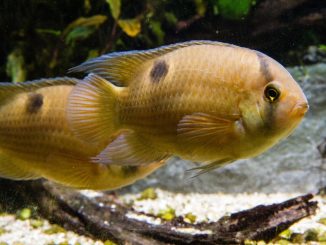
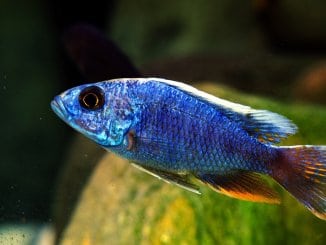
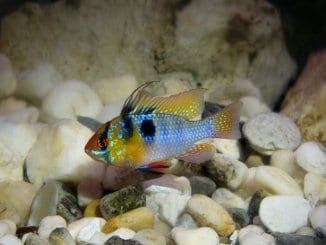

I think it’s adorable when you see the group of them and they have a small conflict that ends with both fish spooking the other and swimming away.
Thanks for this. I have my first pair of rams. Can you give more details of how to tell the male and female apart? The per shop said the bigger or my two was male but I can’t see many other differences… oh and will they be happy with gravel? thanks!
When you said daily water changes of 30%?? Wrong!! You will kill everything!!! Monitor the nitrates and THEN do what needs to be done. Changing that much water will cause more issues!!! Do a weekly change not more than 25%.
Thats a big ask in keeping these if needing daily water changes. Am i reading that correctly. Daily water changes?
No, they definitely don’t need daily water changes.
Contrary to what Mary says, 30% water changes won’t “kill everything!!”, but I wouldn’t be doing daily water changes unless the tank was having major problems with the nitrogen cycle and needed it to keep ammonia and nitrite at tolerable levels.
In a healthy tank, that’s excessive, and is just stressing out your fish for no reason. Ideally, you should decide the frequency and size of your water changes based on nitrate levels, rather than using a rule of thumb for time. I do one on my tanks every few weeks even if the nitrates are low, but I do test occasionally, and if I saw them getting over 20ppm or so, I might increase the frequency or size of the water changes.
I agree 💯!! I’m hoping that was a typo because that’s terrible advise to pass to a new aquarist! That may even be information that will immediately turn off someone from the hobby all together!
I don’t agree with a lot of this. Got a group of 5. They all constantly chased each other. Two died. They are not as easy as you make it sound!